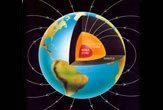Earth's Protective Magnetic Field Older Than Thought

Earth's magnetic field was at least half as strong 3.2 billion years ago as it is today, researchers report.
That means the planet was pretty well protected way back then from solar output that could otherwise have stripped away the atmosphere and doused early living organisms with lethal radiation.
"The intensity of the ancient magnetic field was very similar to today's intensity," said geophysicist John Tarduno of the University of Rochester. "It's interesting because it could mean the Earth already had a solid iron inner core 3.2 billion years ago, which is at the very limit of what theoretical models of the Earth's formation could predict."
Records of Earth that far back are difficult to find, because geologic activity has folded most rocks from that era back into the planet multiple times and spat it out as molten rock. Further, scientists don't know exactly what Earth was like early on, nor when it cooled enough to form the rocky ball with an iron core that we know today.
Why it matters
The Earth's rotating and convecting iron core gives rise to the planet's magnetic field, which billows out from the poles along invisible field lines that can be thought of as resembling the wireframe model of a giant pumpkin. The field acts as a shield against harmful solar radiation and cosmic rays.
Scientists don't know exactly how the magnetic field is created, however, and a better understanding will be needed when pondering the possibility for life on other worlds.
Get the world’s most fascinating discoveries delivered straight to your inbox.
For instance, Mars, which has only limited magnetic activity, is considered very inhospitable to most life as we know it because of the extra radiation that reaches its surface. Scientists think Mars once had a stronger magnetic field, and its loss allowed the sun to erode the planet's atmosphere away.
The new finding, detailed in the April 5 issue of the journal Nature, adds to mounting research about continents and the presence of water that suggest Earth was a much more habitable place 3 billion years ago than scientists have long suspected.
Back in time
Tarduno had previously estimated that as far back as 2.5 billion years ago, Earth's magnetic field was just as intense as today. The new estimate was made by using a laser to heat ancient crystals of feldspar and quartz and measuring their magnetic intensity.
The tiny grains were picked out of out of 3.2 billion-year-old granite outcroppings in South Africa.
"The data suggest that the ancient magnetic field strength was at least 50 percent of the present-day field," Tarduno said. "This means that a magnetosphere was definitely present, sheltering the Earth 3.2 billion years ago."
- 101 Amazing Earth Facts
- Huge 'Ocean' Discovered Inside Earth
- Top 10 Ways to Destroy Earth
Robert is an independent health and science journalist and writer based in Phoenix, Arizona. He is a former editor-in-chief of Live Science with over 20 years of experience as a reporter and editor. He has worked on websites such as Space.com and Tom's Guide, and is a contributor on Medium, covering how we age and how to optimize the mind and body through time. He has a journalism degree from Humboldt State University in California.



